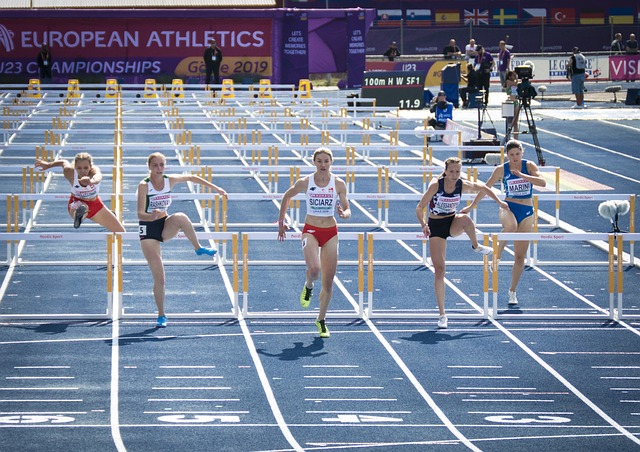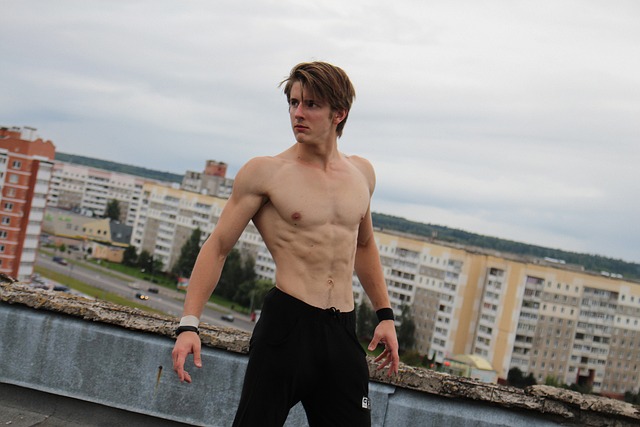Regenerative sports medicine has significantly advanced athletic recovery and muscle repair through innovative treatments like platelet-rich plasma (PRP) and stem cell therapy. These methods accelerate the healing process by leveraging the body's natural regenerative abilities, reducing downtime and enhancing athletes' return to peak performance with improved strength and agility. The focus is on swift and robust recovery, fortifying the musculoskeletal system to increase flexibility and resilience against future injuries. This field also prioritizes overall health and conditioning, offering non-invasive strategies that treat acute injuries while emphasizing long-term athletic performance. By personalizing treatment combinations, regenerative sports medicine enables athletes to recover more quickly and safely, integrating with performance therapy to sustain high levels of athletic success. This holistic approach represents a significant advancement in sports medicine, offering effective, less disruptive alternatives to traditional injury treatments.
Explore the cutting-edge realm of regenerative therapies revolutionizing athletic recovery and performance. This article delves into the transformative potential of muscle repair and sports regeneration, highlighting how these innovations are reshaping the landscape for athletes seeking optimal health and peak performance. From advanced body regeneration techniques to the latest in regenerative sports medicine, discover how integrating performance therapy with regenerative practices can significantly enhance both strength and flexibility. Join us as we explore the new frontier in athletic recovery and sports medicine, where the future of sports performance is taking form.
- Harnessing the Power of Regenerative Therapies for Enhanced Athletic Recovery
- The Role of Muscle Repair and Sports Regeneration in Optimal Performance Therapy
- Accelerating Injury Recovery through Advanced Body Regeneration Techniques
- Innovations in Regenerative Sports Medicine: A New Frontier for Athletes
- Integrating Performance Therapy with Regenerative Practices to Maximize Flexibility and Strength
Harnessing the Power of Regenerative Therapies for Enhanced Athletic Recovery

In the realm of sports performance and recovery, regenerative therapies have emerged as a transformative force in athletic recovery. These advanced treatments, encompassed under regenerative sports medicine, leverage the body’s natural healing processes to accelerate muscle repair and injury recovery. By harnessing the potent restorative capabilities of platelet-rich plasma (PRP) and stem cell therapy, athletes can significantly reduce downtime and return to their sport with improved strength and agility. These treatments stimulate the regeneration of tissues, promoting a swift and robust healing response, which is essential for optimal performance therapy.
Moreover, the integration of these therapies into an athlete’s recovery regimen not only speeds up the return-to-play timeline but also enhances overall flexibility and resilience against future injuries. The body’s regeneration mechanisms are targeted to address specific areas of concern, leading to a more robust and durable musculoskeletal system. This targeted approach in sports regeneration ensures that athletes can safely push the boundaries of their physical capabilities while minimizing the risk of reinjury. As such, regenerative therapies represent a significant advancement in the field of athletic recovery, offering a beacon of hope for those striving to maintain peak performance.
The Role of Muscle Repair and Sports Regeneration in Optimal Performance Therapy

In the realm of athletic recovery and sports regeneration, muscle repair plays a pivotal role in achieving optimal performance therapy outcomes. Regenerative sports medicine encompasses a suite of interventions aimed at restoring an athlete’s physical capabilities post-injury. These therapies leverage the body’s innate regenerative properties to accelerate the healing process, often incorporating advanced techniques such as stem cell therapy and platelet-rich plasma (PRP) injections. By promoting the growth of new muscle tissues and enhancing the body’s natural repair mechanisms, athletes can return to their sport with improved strength and flexibility, laying a solid foundation for peak performance.
The integration of injury recovery strategies within performance therapy has become increasingly sophisticated, thanks to advancements in regenerative sports medicine. This specialized field not only addresses acute injuries but also focuses on the overall health and conditioning of athletes, ensuring they can train harder and smarter without risking overuse injuries or compromising their long-term athletic career. The goal is to restore the body’s balance, allowing for the maintenance of optimal muscle function and joint stability, which are crucial for top-tier athletic performance. Through a tailored approach that combines medical expertise with cutting-edge technology, athletes can achieve faster recovery times and greater resilience against future injuries.
Accelerating Injury Recovery through Advanced Body Regeneration Techniques

Athletic recovery can be significantly accelerated through the advent of advanced regenerative therapies, which have become a cornerstone in sports regeneration. These innovative techniques not only expedite muscle repair but also enhance overall performance therapy outcomes for athletes facing injury recoveries. Utilizing stem cell treatments and platelet-rich plasma (PRP) injections, these therapies stimulate the body’s innate healing processes, leading to improved tissue regeneration and a quicker return to peak physical condition. This is particularly beneficial in sports regeneration as it allows athletes to heal from injuries with minimal downtime, preserving their competitive edge and maintaining their performance levels.
Regenerative sports medicine has made strides in the field of body regeneration by offering non-surgical alternatives that are less invasive yet highly effective. These treatments are tailored to address specific sports injuries, promoting faster healing and reducing the risk of re-injury. By leveraging the body’s natural repair mechanisms, athletes experience a more efficient recovery process, which is crucial for maintaining flexibility and strength in their athletic routines. The integration of regenerative therapies into performance therapy protocols has become an indispensable tool for athletes looking to overcome injuries and enhance their recovery trajectory.
Innovations in Regenerative Sports Medicine: A New Frontier for Athletes

Athletes are constantly seeking innovative methods to enhance their performance and accelerate their recovery, leading to a surge in interest for regenerative sports medicine. This burgeoning field combines advanced biotechnological treatments with traditional athletic recovery techniques to foster muscle repair and injury recovery. Regenerative sports medicine harnesses the body’s natural healing mechanisms to address various orthopedic issues, from acute injuries to chronic overuse conditions. By leveraging stem cell therapies, platelet-rich plasma (PRP) injections, and other cutting-edge technologies, athletes can now repair muscle tissue more effectively, reducing downtime and improving overall performance therapy outcomes. These interventions not only aid in recovery but also promote the longevity of athletic careers by mitigating wear and tear on the body.
The integration of regenerative therapies into sports medicine represents a significant leap forward for athletes looking to extend their peak performance years and recover from injuries with greater speed and efficiency. The use of PRP, for instance, involves isolating growth factors from a patient’s blood cells and reinjecting them into an injury site to accelerate tissue repair. Similarly, stem cell treatments offer the promise of regenerating damaged tissues and organs, potentially restoring an athlete’s performance closer to their pre-injury level. This new frontier in sports medicine is not just about treating injuries; it’s about optimizing the body’s innate capacity for self-repair, thereby enhancing athletic recovery and enabling athletes to push beyond previous limitations. As research continues to advance, regenerative sports medicine is poised to revolutionize how athletes approach their training, competition, and recovery regimens.
Integrating Performance Therapy with Regenerative Practices to Maximize Flexibility and Strength

Athletes and active individuals seeking to enhance their strength and flexibility can benefit significantly from integrating performance therapy with regenerative practices. Performance therapy, a multifaceted approach that includes physical therapy, sports massage, and targeted exercises, works synergistically with regenerative sports medicine techniques such as platelet-rich plasma (PRP) injections and stem cell therapies. These interventions stimulate the body’s natural healing processes to repair damaged tissues, promote muscle recovery, and improve overall athletic performance. By incorporating these advanced therapies into their training regimen, athletes can accelerate their recovery from injuries, optimize muscle function, and achieve unprecedented levels of flexibility and strength.
The synergy between performance therapy and regenerative sports medicine is particularly effective in addressing acute and chronic sports injuries. Regenerative practices like PRP and stem cell treatments release growth factors that signal the body to repair injured tissues, leading to faster recovery times. Combined with targeted rehabilitation exercises, this approach not only helps in restoring function but also enhances the resilience of the muscles, tendons, and ligaments, thus reducing the likelihood of future injuries. As a result, athletes experience improved range of motion, increased strength, and a heightened capacity to perform at their peak potential.
Regenerative therapies represent a paradigm shift in the realm of athletic recovery and performance optimization. By leveraging muscle repair techniques and integrating advanced body regeneration methods, these innovative approaches enable athletes to return to their peak performance levels more swiftly. The integration of performance therapy with regenerative practices has proven effective in maximizing both strength and flexibility, offering a new frontier in sports regeneration that promises to redefine athletic potential. As the field continues to evolve, it is clear that these therapies will play an increasingly significant role in injury recovery and enhancing overall athletic capabilities. Athletes at all levels stand to benefit from the strategic application of these cutting-edge methods, marking a new era in sports medicine and human performance enhancement.
